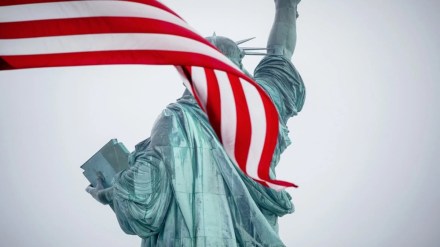By Harsh V Pant & Vivek Mishra
There is a growing chasm in the American socio-political landscape, which is aggressively manifesting in the changes we see unfolding in the country today. The American identity, along with the politics rooted in it, is turning a corner—perceptibly for the worse. Race, identity, and religion have come to take centre stage in a vengeful manner amidst a churn that has divided the country like never before. If the victory of Donald Trump in his second term was a premonition of what was to come, the developments that have followed suggest even more acute crises, and possibly a fundamental one. Two prominent shifts are leading the charge in defining the characteristics of a transforming America. First is the top-down, assertive executive leadership under the Trump administration, which is enforcing policy changes, reversals, and even backlash. The second is the bottom-up swell in American domestic politics, fuelled by the MAGA (Make America Great Again) movement, which is not only deepening the divide between Republicans and Democrats but also fuelling internal dissensions within the American right. These two factors have converged in the executive order signed by President Trump, which seeks to restrict and regulate the entry of non-immigrant workers through the H-1B visa. The implications of these decisions have direct and ripple effects on the Indian diaspora in the US, as well as on India-US relations.
On September 19, President Trump signed an executive order aimed at regulating, and in effect, nearly ending the H-1B programme by imposing a significant fee hike of $100,000 on this category of visas, which allows skilled workers to work in the United States. Initially, the announcement seemed poorly thought out, as it lacked clarity, leaving thousands of H-1B holders—especially those travelling outside the US or planning to do so—in a state of confusion. A clarification stating that the fee increase would only apply to new applicants in the next cycle was a necessary step. Politically, this decision marks the culmination of internal strife within America, where Trump’s hardcore MAGA base opposes immigration as a principle, while tech industry backers of Trump—who rely on skilled foreign workers—push back. Trump himself has wavered between wanting to eliminate H-1B and calling it a “great programme”.
Implications for Indian talent and global IT
The new visa fee hike could effectively cripple the H-1B programme, severely impacting the mobility of workers from India to the US—a trend that has long been a key feature of bilateral relations. In 2024, India accounted for 71% of approved H-1B visas, making it the largest recipient. The skilled Indian workforce, particularly in the information technology (IT) sector, has carved out a significant niche in the US, both by serving as a bridge for tech and innovation between the two countries and by contributing to the growth of the American economy. In fact, at least 65% of those working in the US IT sector are on H-1B visas, with the majority hailing from India.
Broader economic and diplomatic impact
The real impact of these developments is still being assessed, but what is immediately apparent is the potentially massive financial impact these changes could have on the American economy. The first major challenge facing US tech companies like Amazon, Google, Meta, Microsoft, Apple, and IBM will be determining a strategy to either retain their foreign talent currently on H-1B visas or develop a mechanism to comply with the Trump administration’s directive to train Americans for the same roles. Given Trump’s historically unpredictable stance on the H-1B programme and his shifting goals with tech entrepreneurs, it’s possible that Trump could revise his hard-line position to accommodate some of Big Tech’s concerns. However, he is likely to remain torn between appeasing his MAGA base—who are viscerally against immigration, especially for relatively higher paid jobs—and navigating these concerns.
Much of Trump’s campaign for his second presidency was built around an “us versus them” narrative which was primarily focused on the political divide between Democrats and Republicans. While there were moments during the campaign when this divide took on racial and xenophobic tones, especially within the MAGA ranks, the undercurrents were often less overt. The side-lining of Vivek Ramaswamy from the DOGE (Department of Government Efficiency) and the racially charged backlash against Trump’s nomination of Sriram Krishnan as his artificial intelligence advisor were perhaps the two clearest signals of this malaise. Today, however, the shrill of this growing divide in America has reached a crescendo. A programme that allowed the US to attract global talent and configure its services sector is now being targeted in ways that is likely to reshape the US industry and tech sector.
These developments are taking place against the backdrop of the resumed US-India trade talks. India is likely to raise this issue with the Trump administration even as it seeks to turn this crisis into a potentially gainful opportunity. There is, however, a pragmatic understanding in India regarding the question of talent absorption within the country’s tech and IT sector. Many Indian outsourcing giants like TCS and Infosys seem to have long anticipated this shift, and have been investing in local talent and expanding offshore delivery capabilities. As employers grow increasingly hesitant to bear the high costs of visa sponsorship, there is likely to be a stronger move toward remote contracting, offshore services, and gig-based work. While this crisis could mark the beginning of the development of a home-grown talent base, it also signals a potential long-term shift in global talent flows.
The writers are respectively vice-president, studies and foreign policy, and fellow, Americas, Observer Research Foundation.
Disclaimer: Views expressed are personal and do not reflect the official position or policy of FinancialExpress.com. Reproducing this content without permission is prohibited.
